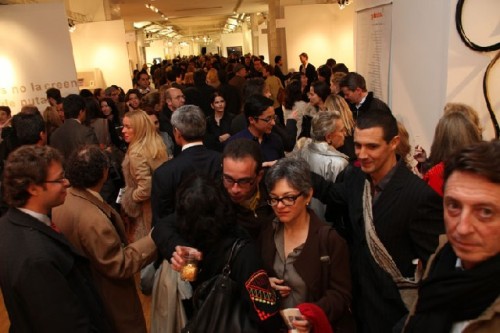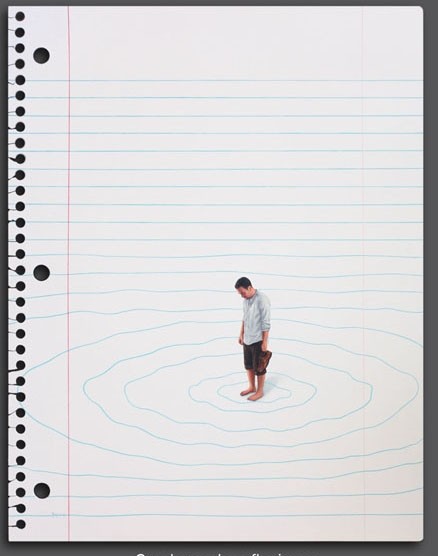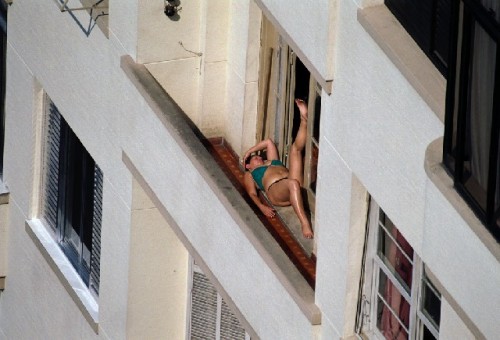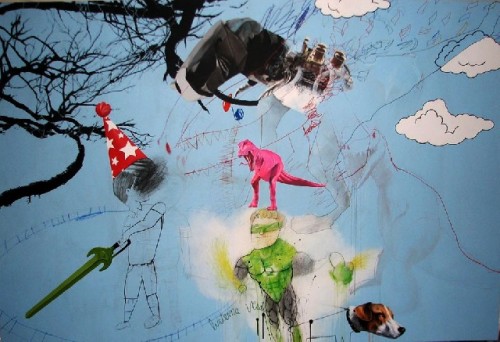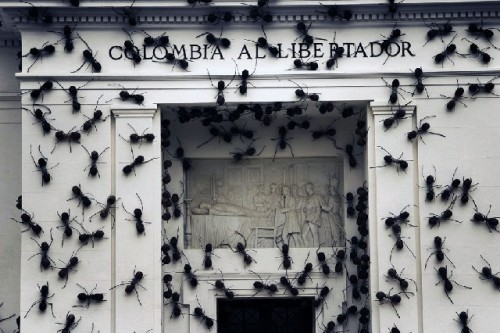Pinta: The 2010 Modern & Contemporary Latin American Art Show
Riding the Crest of the Latin American Art Wave
By: Edward Rubin - Feb 27, 2011
It was only a few years ago, 2007 to be exact, that ‘The Pinta People’ taking a big gamble took the art world by surprise by mounting the world’s first international Latin American Modern & Contemporary Art Show at the Metropolitan Pavilion in New York City.
With 35 international galleries and countless Hispanic artists from the United States, Spain, Mexico, Central and South America, showing their works, the fair was an immediate hit. So much so that Pinta felt secure enough to not only turn this fair into a yearly event but to eventually establish yet another Latin American art fair to be held each year, during the month of June, in the city of London.
This past November, ‘the little fair that could’ took another gamble and moved its 4-day, New York City celebration of Latin American art from its Chelsea habitat to pier 92 on the Hudson River, the same location made famous by The Armory Show. With daylight streaming in from the pier’s surrounding windows, the new and improved Pinta with larger and brighter aisles, more galleries and art installations, a bar and café for the public, and a private, upper level VIP section – with roughly four times more space than the old Pinta – generously gifted its visitors and exhibitors alike with more breathing and thinking room, as well as strolling, eating, and oh my tired feet, resting options.
Again, the golden glow of success reared its lovely head and close to 12,000 art-loving people visited the fair’s 57 participating galleries, the majority being from New York City and Sao Paulo, Brazil. More importantly, sales to private and institutional collectors, according to Pinta’s favorable wrap-up report, were “significant.” Among those institutions buying art was the Bronx Museum of the Arts, New York’s El Museo del Barrio, the Philadelphia Museum of Art, and the Harvard museums. Also seen looking for bargains at Pinta’s new space were museum bigwigs, chief among them, wearing a snazzy pink scarf, was MoMA’s director, Glen Lowry.
Although the art of legendary artists Fernando Botero, Wilfredo Lam, Lygia Clark, and Ana Mendieta, as they did in the first three editions of Pinta, took their customary bows, for the most part, it was the work of the young contemporary Latin American artists whose fresh and unique ways at looking at life that supplied the majority of the fair’s visual excitement. Though many paintings, sculptures, and a few videos were on view, it was the quietly inventive work of the photographers – digital and otherwise – that depicted life, in its myriad postures, most interestingly.
The work of Brazilian artist Rochelle Costi at the Celma Albuquerque Galeria De Arte (Rio de Janeiro) is about scale and perception of space. In one photograph, two stacks of hand-cut paper, lined up side by side, inhabit a one-window, dollhouse-sized room. In another, titled Disproportionally, the floor of the room is covered with a few dozen little metal containers, the type that holds rolls of film. Both objects, deliberately placed in their miniaturized settings by the artist, add a disorienting effect to the photos.
Our eyes dart back and forth, from the window to the ceiling to the floor, to the object and back, trying to make visual sense of what we are looking at. Are the objects large or small, and what size is the room? As Costi wrote, “The series was made using a model of a house where odd objects were introduced to stress the difficulty that we have in realizing the amount of space we really need to live. Have we grown up too much,” Costi asks. Has the environment swallowed us? Is growing up not fitting anymore?”
In his digitally composed photographic series Travelers in Time at Dean Project (New York) Barcelona based artist Lluis Barba, startles the brain by adding unexpected contemporary images, somewhat humorously, into the scenario of classical paintings. In Brueghel’s Peasant Wedding (1568) modern day tourists are seen posing and partying among Brueghel’s 16th century wedding guests.
In Project of the Adequacy of the Great Gallery of the Louvre Barba, re-envisions Hurbert Robert’s 1796 painting of the Louvre, by re-hangs the museum’s walls with the work of twentieth century masters such as Picasso, Magritte, Rothko, and adding present day museum goers into the mix. Even more topical, a portrait of Michael Jackson, and what seems to be, the figure of designer Karl Lagerfeld with wearing his trademark sunglasses, has been slipped into the scene. The artist seems to be saying that art and fashion continually change but human behavior remains the same.
None of videos on view were as visually exciting, lushly colored, and as intellectually stimulating as those of Nicaragua born, New York City based artist Jessica Lagunas at the Rollo Contemporary Art (London, England). In this series the artist herself – in three separate wall-mounted screens – is seen putting on lipstick, applying mascara and painting her nails, all in an overly exaggerated manner. Frantically transforming her lips, eyelashes and fingernails, until they become almost clown-like, Lagunas’s videos using Little Red Riding Hood titles,
The Better To Caress You, The Better To See You With, and The Better To Kiss You With, parody the various “must do” female beauty routines that Madison Avenue and Hollywood, have been hawking for decades. In doing so, she is attempting to undermine the authority of contemporary visual culture’s representation of the female body by re-presenting it in terms of insecurity and obsession.
A few months later, much to my surprise, these same Lagunas videos, apparently making the rounds, were entertaining crowds at the opening of curator Sasha Okshteyn’s exhibition Basic Instinct at the Black and White Gallery in Williamsburg, Brooklyn. Known for having a keen eye and finger on the pulse, I have a sneaky suspicion that Okshteyn – like a few curators I know – must have been doing some pre-exhibition shopping at Pinta.
The narrative work of Paris born, Argentina based photographer Luna Paiva, at the Galeria Teresa Anchorena (Buenos Aires, Argentina), is all about drama. Whether it’s her edgy series of scantily clothed show-girls, known as vedettes, posing inside their homes or her telling portraits of everyday people at home and at work, behind every photograph lurks a fascinating story. One eye-popping surreal Paiva photograph of a woman manically plucking a chicken pulled me right into the gallery.
With one arm in the air, and feathers magically flying everywhere, the lady stands behind a long fruit, fowl, and vegetable laden table that would do any still life painting proud. As the story goes, Paiva, at the bequest of singer Candelaria Saenz Valiente, composed this sumptuous scenario – reminiscent of Peter Greenaway’s 1989 movie, The Cook, The Thief, His Wife, and Her Lover, at a friend’s antique shop, to illustrate the Argentine chanteuse’s song Electrodomesticsr.
Equally, but opposite in their ability to excite, are the photographs of Brazilian photographer, Felipe Morozini, at the Zipper Galeria (São Paulo, Brazil). Using a zoom lens, Morozini – exercising his voyeuristic rights – secretly documents the lives of his neighbors from the window of his apartment. In one photograph, a woman soaking up the sun in a two-piece bathing suit is seen lying precariously on the ledge just outside her apartment window.
In another, a naked woman standing on her balcony is examining herself in a mirror. As luck would have it – chance plays a large part in Morozini’s work – the very instant he took a snapshot, the mirror was reflecting his neighbor’s nipple. In Bride of the Wind (2007), the artist turning his gaze on the temporal qualities of nature, depicts – in 16 sequenced frames – the various effects of the wind on a set of curtains hanging out of an apartment window. Following the twisting and turning movements of each curtain, frame by frame, I found the windmill of my mind making its own little movie.
Galería Christopher Paschall S.XXI (Bogatå, Columbia), one of a handful of galleries that did so, dedicated their entire exhibition space to Casa Tomada (Seized Home), Columbian conceptual artist Rafael Gómez Barros’s traveling installation. Using nature’s little, but hard-working creatures, for political purposes – his intent is to symbolize the people displaced by the continuing armed conflict and the resulting forced migration in Columbia – Barros attaches hundreds, sometimes thousands of fiberglass ants, enlarged to the size of scary, to the facades of government buildings and revered historical monuments such the National Congress of Columbia and Quinta de San Pedro San Pedro in Santa Marta, one the nation’s many shrines dedicated to Simón Bolívar. One gallery wall, covered with a trail of giant black ants, was stopping people in their tracks.
Another wall featuring photographs of Barros’s ants invading various buildings, brought to mind the countless science fiction movies that were popular in the 50s and 60s, like Them (1954), in which giant ants made large by an atomic bomb explosion, threaten to take over the world.
Even before I entered the Lyle O. Reitzel Gallery (Santa Domingo, Dominican Republic), Brooklyn based, Dominican born, Gerald Ellis’s stunningly composed painting Birthday Piñata (2010), with its knockout vibrant blue sky, took me prisoner. The artist’s beautifully drawn images of a dinosaurs, and cartoon-like white clouds, under which a birthday boy with a toy sword in his hand stands, captures all of the innocence of childhood.
Autobiographical by nature, the painting channels the negative feelings that Ellis experienced as a child when called upon to smash open the piñata. “I hated going to birthday parties and always tried to stay away from clowns and the piñatas,” Ellis wrote to me. “I think this funny looking object (the piñata) can detonate a very strong and violent behavior on the child, who is, after destroying the object, fighting his way through into getting as much as he can from what was inside it. I view this as an early example of what really moves us as humans, from a selfish point of view.”
No fair is complete without a touch of eroticism and Brazilian artist Vincent Gill more than made up for it in his series Read the Book, Watch the Movie (2004) at Galeria Nara Roesler (São Paulo, Brazil). Each drawing, executed in India ink on pages taken from a psychology books – like a modern day Kama Sutra – lustily depicts various sexual positions. A few of the book’s words, those not blotted out by the black ink which covers most of the page, serve to illuminate the each image, while white, topsy-turvy line drawings illustrate the love-making figures.
The words on one drawing of a penis penetrating a vagina read Another was the one who introduced the concept for the first time. Another text accompanying the image of a man and woman in head to toe position announces that All kinds of things come together. A third, somewhat ambiguous drawing of a naked woman leaning over a bed – it is left up to the viewer’s imagination as to what is going to take place – reads anxiety by chastisement.
At first glance, the simple paintings of Mexican artist Hugo Lugo at the Ginocchio Gallery (Mexico City, Mexico), executed on pages torn from a spiral notebook, the type we took with us to college, appear to be a simple mix of drawing and collage. On closer inspection – talking about trompe l’oeil – each work, down to the page’s torn holes and the solitary men that occupy each page, is a fully realized oil and acrylic painting on board. Equally deceiving is the subject matter, for here the artist, waxing existential in his presentation of solitary thinking characters in a simple situations, forces us to consider on our own existence.
In one painting the artist, turns the page’s straight lines into a wavering whirlpool and places a barefoot man, with shoes in hand, and head bent down, at its very center. The painting aptly titled Cuadernode de Reflexiones (Book of Reflections), seems to be saying that we are at the center of everything that is going on around us. Another less felicitous reading could be that it is only a matter of time before we are sucked into this circle of nothingness.
The most unusual installation at the Pinta belonged to Venezuelan born, Miami based, fashion designer Nicolás Felizola’s who dedicated exhibition space to the memory of Mexican actress María Félix (1914-2002), Latin America’s revered movie goddess. Known as La Doña to her most loving fans, myself included, Felíx was a huge star throughout Central and South American and Europe during the 40s, 50s and 60s. Cast in films by Renior, Buñuel, Emilio Fernández and Juan Antonio Bardem, with such greats as Rossano Brazzi, Vittorio Gassman, Jean Gabin, and Yves Montand, Felíx refused to work in Hollywood unless she made her grand entrance from the "big door" and not the small roles offered by Cecil B. de Mille. "I was not born to carry a basket,” Félix is reputed to have said.
The backstory here is that in 2007 Felizola, attending Maria Felíx’s after-death auction at Christie’s left the premises owning the most comprehensive collection of the movie star’s couture designed wardrobe. Some of these – by Dior, Balenciaga, Hermes, Chanel, Halston, Cardin, and some of Felizola’s own Felíx inspired creations – are displayed on mannequins.
Running alongside, what is essentially a visual timeline of Felíx’s devotion to fashion and film through her costumes, garments, hats, and accessories, is Carmen Castilla’s 2001 documentary film, Maria Felíx, The Making of a Myth. Structured around an exclusive interview in which the still radiant 87 year old Maria Felix responds to an unseen narrator. Félix talks about her films, her men, her clothes and jewels. Thus, little by little, the legend unfurled. Fully saturated, after having spent a wonder-filled half-day at Pinta, I made for the door.

